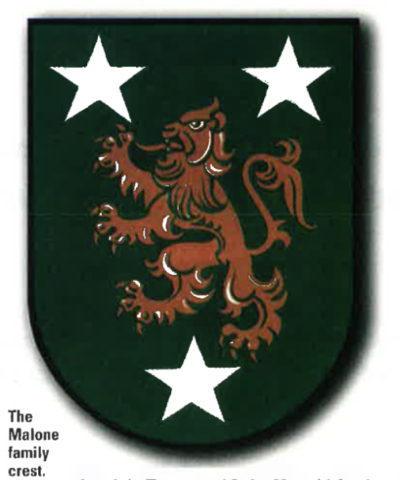This month’s pair of sound-alike names are Moloney and Malone. As with others that have been featured, they bear no relationship to each other. Moloney is derived from the Gaelic O Maoldhomnaigh meaning a descendant of a servant of the church. The name is also often spelled Maloney but the O’Moloney (or O’Maloney) form of the name is only rarely found. The family was originally associated with the area around Tulla, County Clare but is now commonly found in Limerick and Tipperary. The North Tipperary name Maloughney has also been transformed to Moloney in some cases.
The name Malone derives from the Gaelic O’Maoileoin meaning follower of St. John. The family originally came from Ballynahown, County Offaly. The famous monastic site of Clonmacnois is within the Malone territory and several Malones served there as abbots and bishops. The name is now widespread throughout Ireland.
A notable member of the first family is Martin Moloney (1847-1929) who was born in Thurles, County Tipperary. While he was still a baby, his parents were forced to emigrate from famine-stricken Ireland, leaving their children behind in the care of relatives. It was 1854 before his parents could bring their children to the U.S. to live. Martin developed a keen interest in chemistry and invented and patented a gas burner for use in street lighting. On the strength of this invention he established the Moloney Manufacturing and Lighting Company. His burner quickly became a success and he obtained many prestigious and large contracts for lighting. Among these were the Centennial Exposition, and the streets of Philadelphia, Pittsburgh and Jersey. This success allowed Martin to form the Pennsylvania Globe Gas Light Company, from which, by means of aquisitions and expansion, he formed the Philadelphia Electric Company. This success in turn led hun to become a factor in the Electric Company of America. He was also an early investor in Standard Oil, the Pennsylvania Railroad and held many other interests. He spent a large part of his wealth on the Catholic church. He built five churches in the U.S. and generously contributed to the church in France and Italy. He paid for the restoration of St. John Lateran in Rome. Among his other endowments were chemistry laboratories, homes for the aged and the Maloney Clinic in the University of Pennsylvania. In 1903, Pope Leo XIII made him a Papal Marquis.
Another religious member of the clan was Belinda Moloney (1781-1865) who was born in Clare and became a Presentation nun. Her order sent her and two colleagues to Newfoundland, Canada to develop schools. She and her companions were the first nuns to reach Newfoundland where she continued working with children for the rest of her life.
Moloneys of a different philosophy were those who joined the army of King James II, who was the champion of the Irish Catholics in the war against King William of Orange. Prominent among these was Captain Daniel Moloney whose estates in County Clare were confiscated in 1703 because of his support of James. In the American Revolutionary Army there were 97 Maloneys, including Lieutenant Thomas Maloney of Lancaster County, Pennsylvania Militia and Captain Maloney of the Privateer Buckram in Massachusetts Naval Service. In modern Ireland, perhaps the most famous holder of the name is Paddy Moloney, leader of the traditional music group, The Chieftains.
Among the more numerous Malones, there were also several famous members of the clergy. One of these was Sylvester Malone (1821-1899) who was born in Trim, County Meath and became a priest in New York. For 55 years he served in the Brooklyn parish of Williamsburg caring for his immigrant countrymen, and taking active part in many political and civil rights issues. In Ireland, his namesake and fellow priest Sylvester Malone (1822-1906) was equally active in the political issues of Ireland. A priest in County Clare, he was an active historian and an ardent supporter of the Gaelic League and of the maintenance of the Irish language. Edmund Malone (1741-1812) born in Dublin, was a critic and Shakespearean scholar who was a confidant and friend to Samuel Johnson, Joshua Reynolds and Edmund Burke.
In the American Revolutionary Army there were 76 Malones, including Captain William Malone of the privateer Harbinger of the Rhode Island Navy and Captain James Malone of Colonel Putnam’s Massachusetts Regiment. The clan were also represented in King James’ Irish Army by Lieutenant Edmund Malone of Colonel Grace’s Regiment, and Cornet John Malone. These two officers were among the nine Malones who were outlawed by the British in 1691 for their support of James II. Several of these Malones fled to continental Europe where they served, like many of their countrymen, in the armies of France and Spain.
In Dublin the most famous Malone was of course Molly Malone who, in the famous song, “wheeled her wheel barrow through streets broad and narrow crying cockles and mussels alive a-live-o.”
Editor’s Note: This article was originally published in the November/December 1998 issue of Irish America. ⬥


Leave a Reply